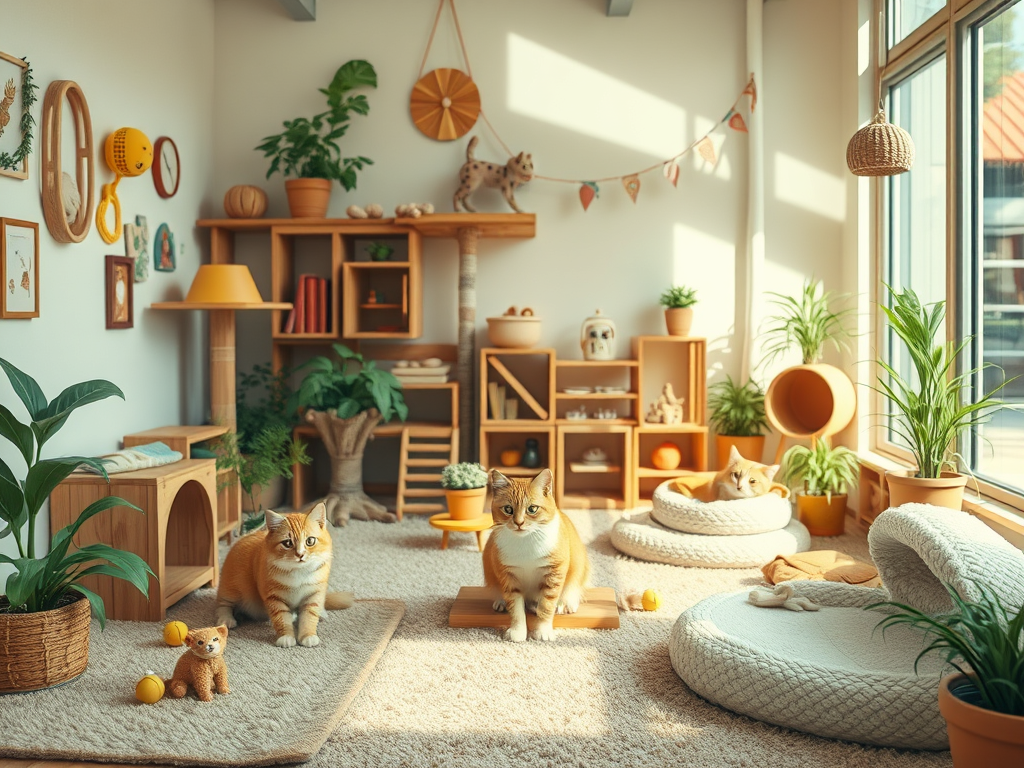Effective Strategies to Reduce Your Cat's Natural Hunting Instincts
Reducing Your Cat's Hunting Impact: Cats are instinctual hunters, a behavior deeply ingrained in their genetic makeup. To create a safe and enriching indoor environment, you can nurture their natural hunting instincts while protecting local wildlife. By strategically designing your living space and incorporating engaging activities that stimulate their senses, you can keep your furry companion mentally engaged and satisfied without endangering vulnerable outdoor animals. This approach ensures that your cat enjoys a fulfilling life while maintaining a balance with nature.
Enhancing your cat's indoor hunting experience can be achieved through the use of interactive toys. Opt for engaging options like feather wands, laser pointers, and motorized mice that keep your pet entertained for longer periods. These toys closely mimic the natural behaviors of hunting, enabling your cat to track and pounce, which is vital for their mental stimulation and physical health. By incorporating these engaging toys into their playtime, you not only provide entertainment but also contribute to their overall well-being by allowing them to expend pent-up energy productively.
Transform your living space into a vibrant feline playground by creating obstacle courses complete with boxes, tunnels, and climbing shelves. This mini jungle gym invites exploration and physical activity, allowing your cat to climb, jump, and investigate diverse environments. Cats are inherently curious, and offering varied spaces to explore can mimic their wild instincts, making them feel as though they are on an exciting adventure in their very own DIY safari.
Never underestimate the effectiveness of puzzle feeders. These innovative devices not only engage your cat's mind but also simulate the effort they would exert while hunting. By incorporating treat-dispensing puzzles into your cat's feeding routine, you can enhance their cognitive skills while providing a fun, rewarding experience. This method not only keeps your pet entertained but also encourages healthier eating habits as they learn to work for their treats, transforming mealtime into an engaging activity.
Prioritizing playtime is essential in your household. Engaging in social interaction through play is vital for strengthening the bond between you and your feline companion. Establish a routine for dedicated play sessions, utilizing their favorite toys to enhance the experience. This joint engagement not only alleviates any frustration your cat may feel but also deepens your connection, turning playtime into a fulfilling and enjoyable experience for both of you.
By utilizing creativity and dedication, you can create a stimulating indoor environment for your cat. Your home can become more than just a shelter; it can evolve into a thrilling landscape that satisfies their natural hunting urges while ensuring their safety from outdoor dangers. With thoughtful planning, you can cultivate a happy and fulfilled indoor cat.

Leash Training for Your Cat: Discover New Adventures Together
Implementing leash training can unlock a world of safe exploration for your cat. While walks are typically associated with dogs, cats can also enjoy outdoor adventures with the right training and patience. By introducing your feline friend to a harness and leash, you can provide them with the chance to experience the beauty of nature without compromising their safety.
Start your leash training journey with a harness that fits snugly yet comfortably on your cat. It’s crucial to allow your pet to become accustomed to the harness before attempting to put it on them. Encourage them to sniff and explore the harness, which can help ease any anxiety they might have. Gradual introduction at their own pace fosters positive associations, making the entire process smoother and more enjoyable for your cat.
Once your cat feels comfortable wearing the harness, attach a lightweight leash and practice indoors. This familiar environment will help them adjust to the sensation of the leash while building their confidence. Be patient and prepared for some initial resistance; understanding that this adjustment takes time is key to helping your cat acclimate to this new and exciting experience.
When you are ready to venture outside for the first time, choose a calm and secure location, such as your backyard or a quiet park. Ensure that the area has minimal traffic and distractions so your cat can feel safe. Start with brief outdoor sessions to avoid overwhelming your pet, gradually increasing the time as they become more comfortable exploring their new surroundings.
Supervised outdoor time enriches your cat's life, allowing them to enjoy the sights, sounds, and scents of nature without posing a threat to local wildlife. Picture the joy on your cat's face as they discover new experiences in a safe setting. This shared time not only enhances their quality of life but also strengthens your bond, creating cherished memories together.
Real-life stories from fellow cat owners can offer inspiration and motivation. Many have expressed initial doubts about whether their cats would take to leash walking, but through consistency and positive reinforcement, they have achieved wonderful results. Celebrate each small success as a step towards widening your cat's horizons while ensuring their safety every step of the way.
By incorporating leash training into your cat's daily routine, you are facilitating a harmonious blend of outdoor enjoyment and wildlife protection. This balanced approach allows your cat to explore while fostering a sense of security in their surroundings.
Creating Safe Outdoor Spaces for Cats: The Benefits of Catios
Outdoor cat enclosures, commonly known as catios, offer an excellent solution for adventurous cats yearning for outdoor experiences without the dangers associated with free roaming. These secure spaces allow your feline friends to enjoy the benefits of the outdoors while ensuring their safety and the protection of local wildlife.
Building or investing in a catio can be customized to suit your space and budget. Options vary from simple balcony enclosures to more intricate backyard constructions. The primary focus should always be on creating an escape-proof structure, as safety is paramount in providing a secure environment for your cat.
When designing your catio, think about incorporating multiple levels and cozy hiding spots. Cats flourish in environments that offer vertical spaces and safe retreats. By adding platforms, ramps, and hammocks, you can transform an ordinary enclosure into an engaging paradise that closely resembles their natural habitat, providing endless opportunities for exploration.
Enhancing the sensory experience within the catio is also beneficial. Introduce elements like cat grass, scratching posts, or logs to create a stimulating environment filled with a variety of textures and scents. This sensory enrichment not only keeps your cat engaged but also allows them to enjoy the great outdoors within a controlled setting, fostering their natural instincts safely.
Regular maintenance is essential for the safety of your catio. Routinely inspect the structure for any signs of wear and tear, including the integrity of the mesh, the overall structure, and the locks. Cats are naturally curious and may test the boundaries of their enclosure, so it's crucial to keep the catio in excellent condition for their safety and well-being.
With a catio, your feline companion can bask in the sun, climb, and observe wildlife without posing a threat to the local ecosystem. They can enjoy the fresh air and watch birds from the safety of their outdoor haven, remaining satisfied while local wildlife stays protected and unharmed.

Proven Training Techniques to Curb Your Cat's Hunting Behaviors
Training your cat to reduce their hunting behaviors may seem daunting, but with the right techniques, it can be a manageable task. The first step is to understand their natural instincts and the behaviors that drive them to hunt, which is essential for implementing effective training strategies tailored to their needs.
Utilizing technology can significantly enhance your training efforts. Consider employing motion-activated deterrents, such as sprinklers or noise-makers, to establish boundaries that discourage hunting while minimizing disruption to other activities. Strategically zoning your yard into safe areas can also help redirect your cat's attention away from potential prey, promoting safer outdoor interactions.
Positive reinforcement plays a crucial role in modifying your cat’s behavior. Reward them for engaging in non-hunting actions with treats or affection. For example, when your cat comes to you when called or refrains from pursuing a potential target, offer them a tasty treat or extra cuddles. This method encourages them to repeat desirable behaviors while gradually decreasing their instinctive urge to hunt.
Incorporating clicker training can also serve as a powerful tool in your training arsenal. This technique involves associating a distinct sound with positive actions, allowing your cat to understand the connection between their behavior and rewards. By clicking at the moment they exhibit desired behaviors, you can reinforce good habits and clarify your expectations, leading to more effective training outcomes.
For personalized support, consider consulting with feline behavior specialists. They can provide tailored advice and insights that address specific challenges you may face, helping you and your cat coexist harmoniously while respecting local wildlife.
The goal of using deterrents and training is not to punish but to guide your cat toward behaviors that prioritize their safety and the well-being of the environment. With consistency, patience, and understanding, you can successfully redirect their instincts, resulting in safer outdoor interactions for both your cat and the local wildlife.
Smart Feeding Strategies to Reduce Your Cat's Hunting Drives
The type of food you provide and the methods you use for feeding can significantly impact your cat's hunting instincts. Interestingly, a well-fed cat may still display hunting behaviors; however, the feeding strategies you adopt can help mitigate this drive and promote healthier habits.
Free feeding, where food is available at all times, may not be the best approach for every cat. Instead, consider implementing a structured schedule for feeding times. By establishing consistent mealtimes, your cat may be less inclined to hunt, as they begin to associate food with specific times during the day, effectively reducing their need to seek out prey.
Interactive feeding strategies can prove transformative for your cat's behavior. Utilizing food puzzles or dispensers can replicate the hunting experience, requiring your cat to ‘work' for their meals. This not only keeps them mentally and physically engaged but also channels their energy positively, allowing their natural instincts to be expressed safely and constructively.
Pay attention to the nutritional content of their food as well. A diet that is rich in protein and low in carbohydrates aligns better with a cat's natural dietary needs, potentially reducing their hunting behaviors. Collaborating with a veterinarian to tailor their diet can ensure that your cat's nutritional requirements are effectively met while promoting overall health.
Finally, offering a variety of food types can satisfy their inherent curiosity and appetite for novelty. Alternating between dry kibble, wet food, and raw diets can keep mealtime exciting, reducing the temptation to seek thrills beyond their food dish. This variety not only enhances their eating experience but also contributes to a balanced diet.
Feeding strategies extend beyond mere sustenance; they are a powerful tool for managing your cat's behavior. By adjusting how and what you feed them, you can effectively diminish their inclination to hunt while keeping them satisfied, healthy, and happy.

Fostering Community Responsibility for Cat Conservation Efforts
Cats are wonderful companions, and as their caregivers, we have a responsibility to ensure they coexist peacefully with local wildlife. By embracing community initiatives and personal accountability, we can significantly reduce the ecological impact of free-roaming cats.
Engaging with local conservation groups is a great way to stay informed about wildlife-friendly practices. Many communities offer educational workshops for cat owners, addressing the ecological consequences of allowing cats to roam freely and providing solutions to minimize these effects.
Consider initiating or participating in neighborhood discussions or social media groups focused on responsible pet ownership. Sharing resources, tips, and experiences can cultivate a more wildlife-conscious community, creating a supportive atmosphere for all pet owners and ensuring our pets live harmoniously with nature.
One proactive approach involves establishing cat-friendly zones within community gardens or parks. These designated areas can include enclosures or supervised play spaces, ensuring a safe environment for both cats and wildlife. This collaborative effort raises awareness and promotes positive interactions between pets and their natural surroundings.
Family-friendly initiatives, such as sticker campaigns or educational contests for children and teens, can also raise awareness about responsible pet ownership and the importance of coexisting with nature. Encouraging young people to engage with these ideas fosters a sense of responsibility toward wildlife conservation.
Lead by example at home by implementing the strategies you’ve learned. Whether it’s leash training, building catios, or adjusting feeding practices, demonstrating a commitment to a harmonious relationship between your cat and the environment can inspire others to adopt similar approaches.
By combining individual actions with community-based initiatives, we can create a supportive network that balances our cats’ needs with environmental stewardship. Together, we can cherish our pets while respecting and protecting the wild spaces around us.
The Article: Minimize Your Cat’s Hunting Impact Appeared First On Unity Pets.
The Article Minimize Hunting Impact of Your Cat Effectively Was Found On https://limitsofstrategy.com

Your insights on reducing a cat’s natural hunting instincts while still engaging them effectively resonate with many pet owners who want to strike a balance between their feline friends’ needs and the ecological impact of their behaviors. I find it particularly interesting how you emphasize the importance of creating an enriching indoor environment. It raises an important conversation about how we, as pet owners, can nurture the instincts that make our cats who they are, without compromising local wildlife.
This is a purrfectly timed discussion! My cat, Sir Fluffington, has definitely taken a keen interest in, well, everything that moves (including my feet). I’ve tried out some interactive toys, and let me tell you, the feather wand has become a serious contender for “Best Entrant in Cat Olympics.” It’s fascinating how something as simple as a toy can channel all that primal energy into a full-blown sofa chase!